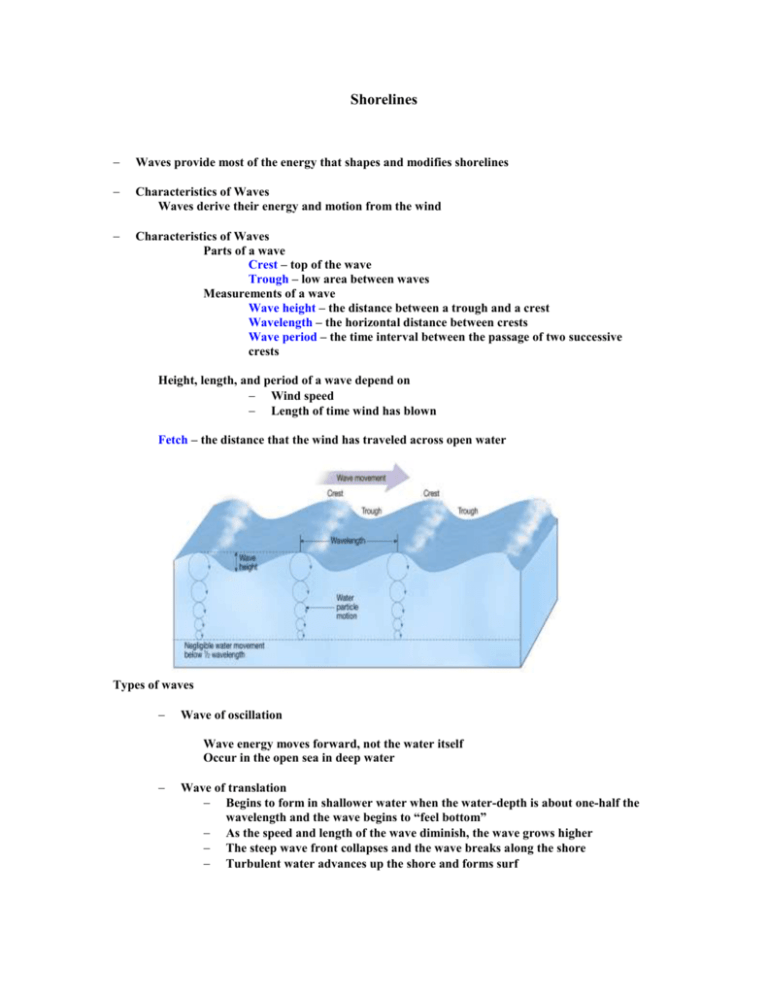Shorelines - This Old Earth
advertisement

Shorelines Waves provide most of the energy that shapes and modifies shorelines Characteristics of Waves Waves derive their energy and motion from the wind Characteristics of Waves Parts of a wave Crest – top of the wave Trough – low area between waves Measurements of a wave Wave height – the distance between a trough and a crest Wavelength – the horizontal distance between crests Wave period – the time interval between the passage of two successive crests Height, length, and period of a wave depend on Wind speed Length of time wind has blown Fetch – the distance that the wind has traveled across open water Types of waves Wave of oscillation Wave energy moves forward, not the water itself Occur in the open sea in deep water Wave of translation Begins to form in shallower water when the water-depth is about one-half the wavelength and the wave begins to “feel bottom” As the speed and length of the wave diminish, the wave grows higher The steep wave front collapses and the wave breaks along the shore Turbulent water advances up the shore and forms surf Wave Erosion Breaking waves exert a great force Wave erosion is caused by Wave impact and pressure Abrasion by rock fragments Wave refraction (Bending of a wave) Causes waves to arrive nearly parallel to the shore Consequences of wave refraction Wave energy is concentrated against the sides and ends of headlands Wave energy is spread out in bays and wave attack is weakened Over time, wave erosion straightens an irregular shoreline Moving sand along the beach – Waves that reach the shoreline at an angle cause the sediment to move along a beach in a zigzag pattern called beach drift Moving sand along the beach Oblique waves also produce longshore currents Currents in the surf zone flow parallel to the coast Easily moves fine suspended sand and rolls larger sand and gravel along the bottom Features of a shorline vary depending on several factors including: The rocks along the shore Currents Wave intensity Whether the coast is stable, sinking, or rising Features caused by wave erosion Wave-cut cliffs Wave-cut platform Features associated with headlands Sea arch Sea stack Features related to beach drift and longshore currents Spits- Elongated ridges of sand extending from the land into the mouth of an adjacent bay Often the end of a spit hooks landward in response to wave-generated currents Baymouth bar – a sand bar that completely crosses a bay Tombolo – a ridge of sand that connects an island to the mainland or another island Barrier islands Mainly along the Atlantic and Gulf coasts Low ridges of sand that parallel the coast 3 to 30 kilometers offshore Probably form in several ways If the shoreline remains stable, the result of shoreline erosion and deposition is to eventually produce a straighter coast Shoreline erosion is influenced by several local factors including: Proximity to sediment-laden rivers Degree of tectonic activity Topography and composition of the land Prevailing wind and weather patterns Configuration of the coastline and nearshore areas Three basic responses to erosion problems: Building structures Jetties Usually built in pairs to develop and maintain harbors Extend into the ocean at the entrances to rivers and harbors Groins Built to maintain or widen beaches Constructed at a right angle to the beach to trap sand Breakwater Barrier built offshore and parallel to the coast Protects boats from the force of large breaking waves Seawall Barrier parallel to shore and close to the beach to protect property Stops waves form reaching the beach areas behind the wall Often the building of structures is not an effective means of protection Three basic responses to erosion problems Beach nourishment The addition of large quantities of sand to the beach system Only an economically viable long-range solution in a few areas Abandonment and relocation of buildings away from the beach







